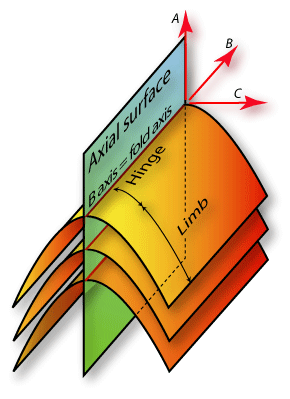|
|
|
Folds Descriptors |
|
|
|
 |
|
|
How comes sometimes rock deform by faulting and sometimes they do so by folding? Since the bedding attitude changes across fold (different strike, dip and dip direction) how can a we characterise the structure of folded stratas? Why should we look at folds anyway? The answer to the last question can be find on the introduction of the 1st yr course (Geol 1002 -Folds) |
|
|
|
There is a simple answer to the first question: No folding without rheological (i.e. strength) layering. Indeed, if an homogeneous body is submitted deviatoric stresses, deformation can only occur in an homogeneous manner. Only when rock formations show alternating layers of contrasting strength do folds develop. |
|
|
|
The attitude of folds (their orientation in space) is characterized by the attitude of both their axial surface and their B axis (also called the fold axis). The B axis corresponds to the fold hinge line, the line linking points of maximum curvature on a folded surface. The axial surface is defined as the surface containing all the hinge lines on successive folded surfaces belonging to the same fold closure. The axial surface can be planar of not, and fold axis can be curved. |
|
|
|
A folded surface displays a succession of anticlinal and synclinal fold hinges (also called fold closures) separated by fold limbs. Across a fold hinge the attitude of the folded surface change significanlty. |
|
|
|
|
|
|
|
|
|
|
|
|
|
|